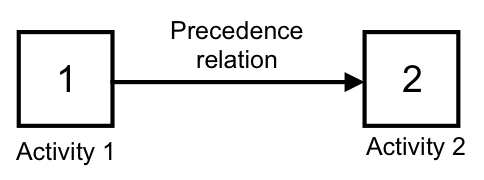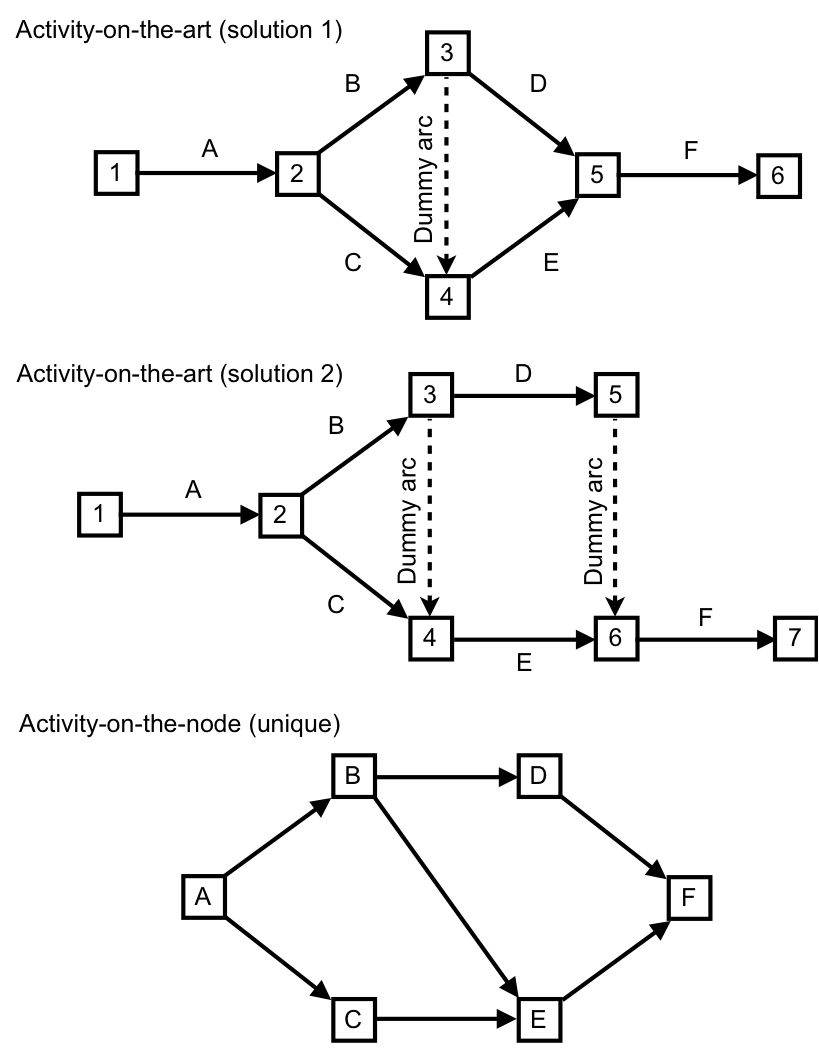Project networks: Nodes and arcs or arcs and nodes?
When finishing this article, you can take a short "Test Yourself" quiz, to ensure you fully understood this topic.
A project network consists of a set of nodes and arcs. A project contains activities and precedence relations to model technological relations between pairs of activities. A project network can be represented in two formats, which is the topic of this article, as follows:
- Activity-on-the-node: activities are represented by nodes and precedence relations by arcs
- Activity-on-the-arc: activities are represented by arcs and the precedence relations are implicitly embedded in the network nodes
Activity-on-the-node (AoN)
In an activity-on-the-node network format, project activities are represented by nodes and precedence relations by arcs between the nodes. Figure 1 displays a precedence relation between two activities in an activity-on-the-node format. It is said that activity 2 is a successor of activity 1 and activity 1 is a predecessor of activity 2.

Figure 1: An example activity link in activity-on-the-node format
This project network format is the default format in most commercial project management software tools such as MS Project, Primavera, ProTrack and many others. This format is easy to use in combination with different types of precedence relations (start-start, start-finish, finish-start and finish-finish relation, see “Activity links: How to add precedence relations between activities?”).
Activity-on-the-arc (AoA)
In an activity-on-the-arc network format, project activities are represented by arcs, as shown in figure 2. The nodes are events (or milestones) denoting the start and/or finish of a set of activities of the project and implicitly model the precedence relations between the nodes.

Figure 2: An example activity link in activity-on-the-arc format
It is said that activity (2,3) is a successor of activity (1,2) and activity (1,2) is a predecessor of activity (2,3).
Unlike the activity-on-the-node format, the activity-on-the-arc network representation requires some rules to follow, which can be summarized in the following lines:
- Unique representation: Each activity can be a uniquely identified by its start and end node
- Single start/end event: Each project network starts and ends with a single event (representing the start and end of the project)
- Dummy activities: Arcs to model extra precedence relations or to fulfill the two requirements written above
Comparison
Table 1 displays a brief comparison between the two project network formats.
Table 1: A comparison between activity-on-the-node and activity-on-the-arc format
| Activity-on-the-arc | Activity-on-the-node |
| Originally used for PERT and CPM | Used by most commercial software tools |
| Network representation is not unique due to dummy activities |
Unique network representation
(no dummy arcs)
|
| Restricted to finish-start with zero time-lags |
Can be easily extended to
start-start, start-finish, finish-start and finish-finish relations with non-zero time-lags
|
An illustrative example is given by the project data of table 2 and the project networks in figure 3. While the AoA project networks are not unique due to the incorporation of one (top) or two (middle) dummy activities, the AoN network never contains dummy activities and is therefore always unique.
Table 2: Project data for an example project
| Activity | Predecessors |
| A | none |
| B | A |
| C | A |
| D | B |
| E | B and C |
| F | D and E |
Figure 3: An AoA (not unique) and AoN (unique) network for the project data of table 2.

© OR-AS. PM Knowledge Center is made by OR-AS bvba | Contact us at info@or-as.be | Visit us at www.or-as.be | Follow us at @ORASTalks



Although this seemed like an easy article, I only scored 67% on the test :-(. I really enjoy to be able to test my knowledge after reading an article. Thank you for this!